PEUGEOT 4007 2012 Owners Manual
Manufacturer: PEUGEOT, Model Year: 2012, Model line: 4007, Model: PEUGEOT 4007 2012Pages: 236, PDF Size: 17.59 MB
Page 111 of 236
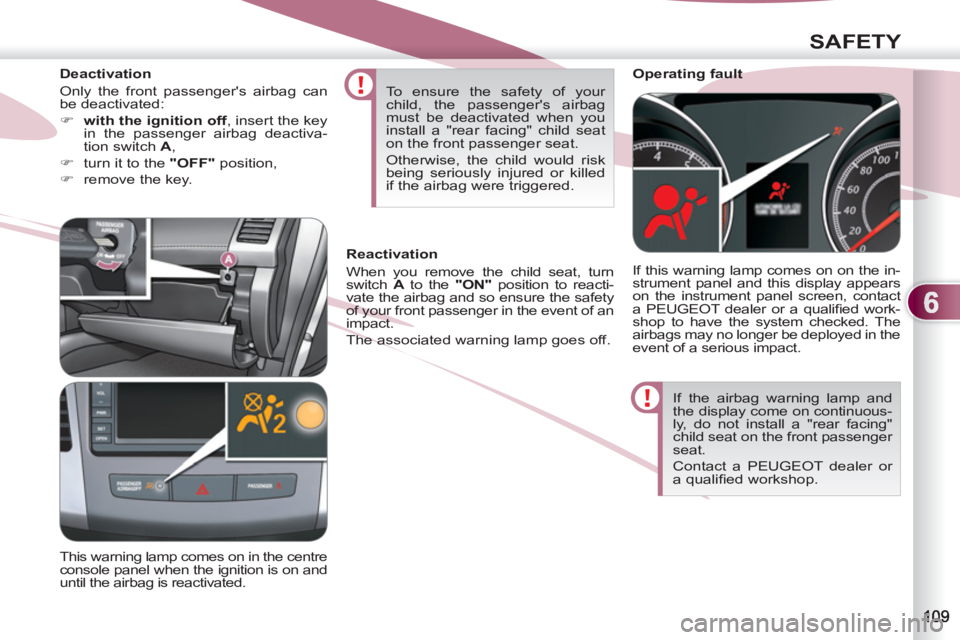
6
SAFETY
If the airbag warning lamp and
the display come on continuous-
ly, do not install a "rear facing"
child seat on the front passenger
seat.
Contact a PEUGEOT dealer or
a qualifi ed workshop.
Operating fault
If this warning lamp comes on on the in-
strument panel and this display appears
on the instrument panel screen, contact
a PEUGEOT dealer or a qualifi ed work-
shop to have the system checked. The
airbags may no longer be deployed in the
event of a serious impact. To ensure the safety of your
child, the passenger's airbag
must be deactivated when you
install a "rear facing" child seat
on the front passenger seat.
Otherwise, the child would risk
being seriously injured or killed
if the airbag were triggered.
This warning lamp comes on in the centre
console panel when the ignition is on and
until the airbag is reactivated.
Reactivation
When you remove the child seat, turn
switch A
to the "ON"
position to reacti-
vate the airbag and so ensure the safety
of your front passenger in the event of an
impact.
The associated warning lamp goes off.
Deactivation
Only the front passenger's airbag can
be deactivated:
�)
with the ignition off
, insert the key
in the passenger airbag deactiva-
tion switch A
,
�)
turn it to the "OFF"
position,
�)
remove the key.
Page 112 of 236
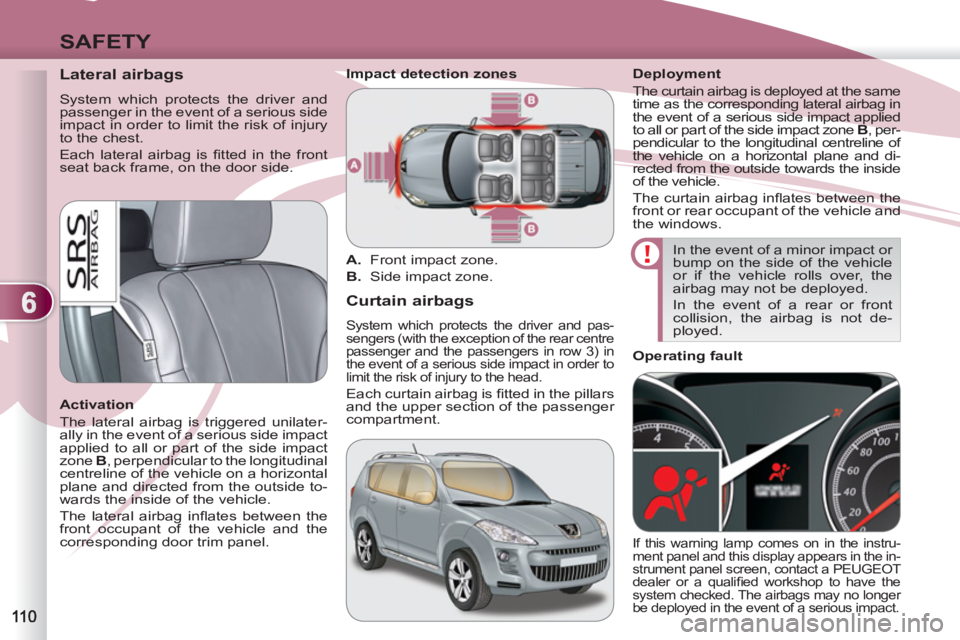
6
SAFETY
Lateral airbags
System which protects the driver and
passenger in the event of a serious side
impact in order to limit the risk of injury
to the chest.
Each lateral airbag is fi tted in the front
seat back frame, on the door side.
Activation
The lateral airbag is triggered unilater-
ally in the event of a serious side impact
applied to all or part of the side impact
zone B
, perpendicular to the longitudinal
centreline of the vehicle on a horizontal
plane and directed from the outside to-
wards the inside of the vehicle.
The lateral airbag infl ates between the
front occupant of the vehicle and the
corresponding door trim panel.
Curtain airbags
System which protects the driver and pas-
sengers (with the exception of the rear centre
passenger and the passengers in row 3) in
the event of a serious side impact in order to
limit the risk of injury to the head.
Each curtain airbag is fi tted in the pillars
and the upper section of the passenger
compartment.
Deployment
The curtain airbag is deployed at the same
time as the corresponding lateral airbag in
the event of a serious side impact applied
to all or part of the side impact zone B
, per-
pendicular to the longitudinal centreline of
the vehicle on a horizontal plane and di-
rected from the outside towards the inside
of the vehicle.
The curtain airbag infl ates between the
front or rear occupant of the vehicle and
the windows.
In the event of a minor impact or
bump on the side of the vehicle
or if the vehicle rolls over, the
airbag may not be deployed.
In the event of a rear or front
collision, the airbag is not de-
ployed.
Impact detection zones
A.
Front impact zone.
B.
Side impact zone.
Operating fault
If this warning lamp comes on in the instru-
ment panel and this display appears in the in-
strument panel screen, contact a PEUGEOT
dealer or a qualifi ed workshop to have the
system checked. The airbags may no longer
be deployed in the event of a serious impact.
Page 113 of 236
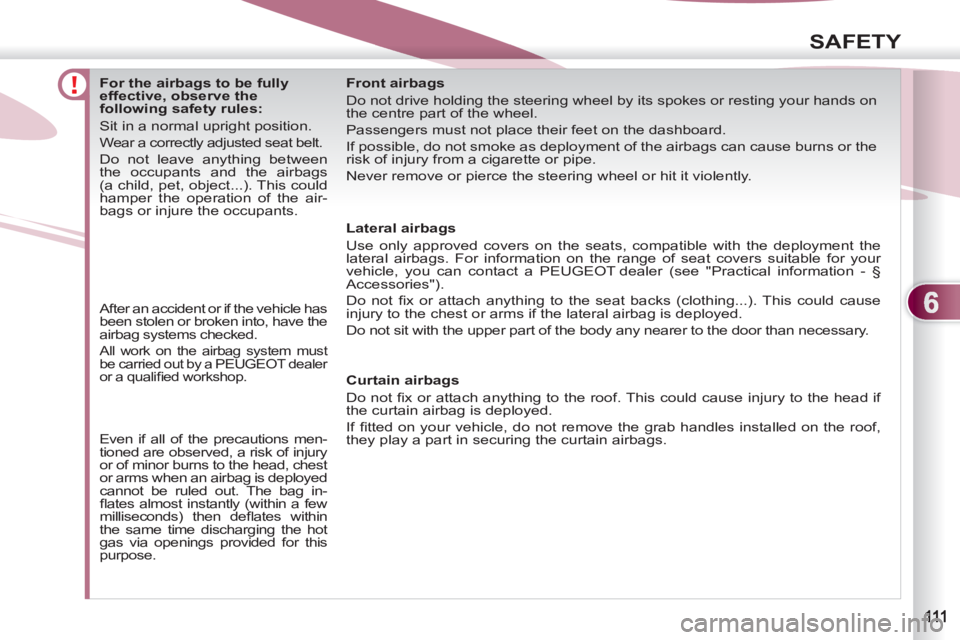
6
SAFETY
For the airbags to be fully
effective, observe the
following safety rules:
Sit in a normal upright position.
Wear a correctly adjusted seat belt.
Do not leave anything between
the occupants and the airbags
(a child, pet, object...). This could
hamper the operation of the air-
bags or injure the occupants.
Lateral airbags
Use only approved covers on the seats, compatible with the deployment the
lateral airbags. For information on the range of seat covers suitable for your
vehicle, you can contact a PEUGEOT dealer (see "Practical information - §
Accessories").
Do not fi x or attach anything to the seat backs (clothing...). This could cause
injury to the chest or arms if the lateral airbag is deployed.
Do not sit with the upper part of the body any nearer to the door than necessary. After an accident or if the vehicle has
been stolen or broken into, have the
airbag systems checked.
All work on the airbag system must
be carried out by a PEUGEOT dealer
or a qualifi ed workshop.
Even if all of the precautions men-
tioned are observed, a risk of injury
or of minor burns to the head, chest
or arms when an airbag is deployed
cannot be ruled out. The bag in-
fl ates almost instantly (within a few
milliseconds) then defl ates within
the same time discharging the hot
gas via openings provided for this
purpose.
Front airbags
Do not drive holding the steering wheel by its spokes or resting your hands on
the centre part of the wheel.
Passengers must not place their feet on the dashboard.
If possible, do not smoke as deployment of the airbags can cause burns or the
risk of injury from a cigarette or pipe.
Never remove or pierce the steering wheel or hit it violently.
Curtain airbags
Do not fi x or attach anything to the roof. This could cause injury to the head if
the curtain airbag is deployed.
If fi tted on your vehicle, do not remove the grab handles installed on the roof,
they play a part in securing the curtain airbags.
Page 114 of 236
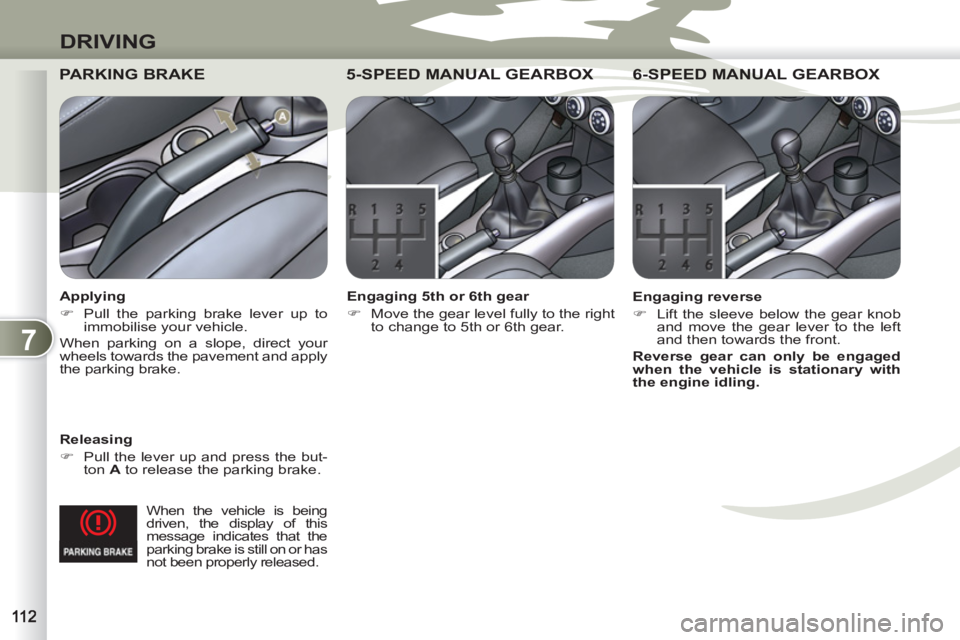
7
DRIVING
When the vehicle is being
driven, the display of this
message indicates that the
parking brake is still on or has
not been properly released.
PARKING BRAKE
Releasing
�)
Pull the lever up and press the but-
ton A
to release the parking brake.
NUAL GEARBOX
5-SPEED MANUAL GEARBOX
Engaging 5 th or 6 th gear
�)
Move the gear level fully to the right
to change to 5 th or 6 th gear.
Applying
�)
Pull the parking brake lever up to
immobilise your vehicle.
When parking on a slope, direct your
wheels towards the pavement and apply
the parking brake.
6-SPEED MANUAL GEARBOX6-SPEED MANUA
Engaging reverse
�)
Lift the sleeve below the gear knob
and move the gear lever to the left
and then towards the front.
Reverse gear can only be engaged
when the vehicle is stationary with
the engine idling.
Page 115 of 236

7
DRIVING
Gear lever positions
N
: neutral.
With your foot on the brake, select this
position to start.
R
: reverse gear.
With the vehicle stationary, keep your
foot on the brake pedal and push the
gear lever forwards.
D
: automated mode.
Move the lever backwards to select this
mode.
+/-: sequential mode with manual gear
changing.
Functions of the steering
mounted control paddles
+
: manual gear changing in sequential
mode.
Press behind the "+"
steering mounted
control paddle to change up.
-
: manual gear changing in sequential
mode.
Press behind the "-"
steering mounted
control paddle to change down.
- a "-"
steering mounted control pad-
dle 2
for sequential downward gear
changes,
- a "+"
steering mounted control pad-
dle 3
for sequential upward gear
changes. Move the lever backwards, then to the
left to select this mode, then:
- push forward to change up,
- push backward to change down.
Moving off
Select position N
.
CVT GEARBOXCVT GEA
The six-speed automatic gearbox of-
fers a choice between the comfort of
automatic regulation or the pleasure of
manual gear changing.
This gearbox has two driving modes:
- an automated mode for automatic
control of the gears by the gearbox
and therefore without any action on
the part of the driver,
- a sequential mode for manual
changing of the gears by the driver
using the steering mounted controls
or the gear lever.
It consists of the following controls:
- a gear lever 1
on the centre console
for selecting the driving mode, reverse
gear and neutral or for changing gear
in sequential mode,
Page 116 of 236
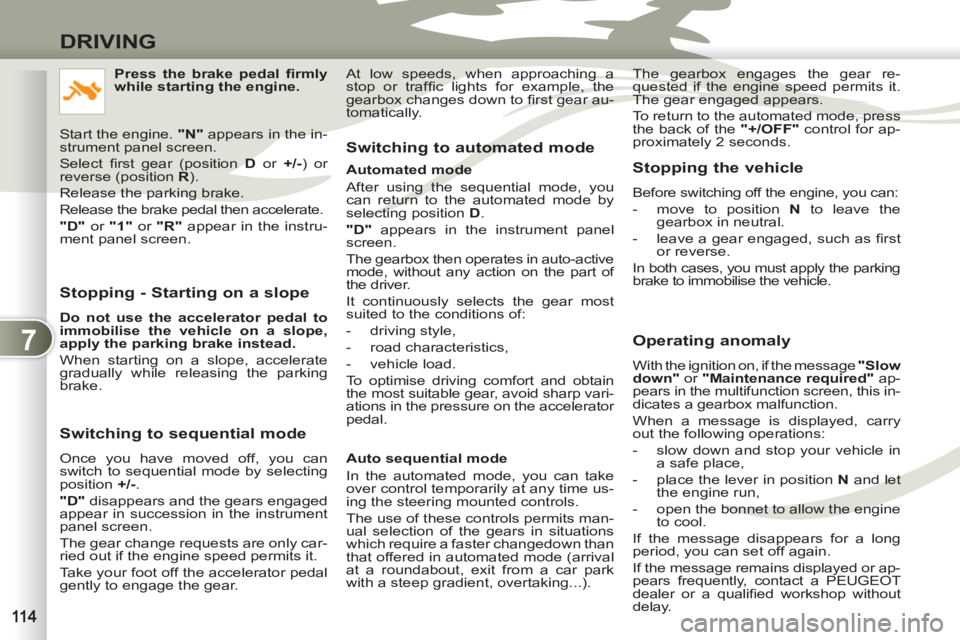
7
DRIVING
Stopping - Starting on a slope
Do not use the accelerator pedal to
immobilise the vehicle on a slope,
apply the parking brake instead.
When starting on a slope, accelerate
gradually while releasing the parking
brake.
Switching to sequential mode
Once you have moved off, you can
switch to sequential mode by selecting
position +/-
.
"D"
disappears and the gears engaged
appear in succession in the instrument
panel screen.
The gear change requests are only car-
ried out if the engine speed permits it.
Take your foot off the accelerator pedal
gently to engage the gear.
Switching to automated mode
Automated mode
After using the sequential mode, you
can return to the automated mode by
selecting position D
.
"D"
appears in the instrument panel
screen.
The gearbox then operates in auto-active
mode, without any action on the part of
the driver.
It continuously selects the gear most
suited to the conditions of:
- driving style,
- road characteristics,
- vehicle load.
To optimise driving comfort and obtain
the most suitable gear, avoid sharp vari-
ations in the pressure on the accelerator
pedal.
Auto sequential mode
In the automated mode, you can take
over control temporarily at any time us-
ing the steering mounted controls.
The use of these controls permits man-
ual selection of the gears in situations
which require a faster changedown than
that offered in automated mode (arrival
at a roundabout, exit from a car park
with a steep gradient, overtaking...).
Stopping the vehicle
Before switching off the engine, you can:
- move to position N
to leave the
gearbox in neutral.
- leave a gear engaged, such as fi rst
or reverse.
In both cases, you must apply the parking
brake to immobilise the vehicle.
Operating anomaly
With the ignition on, if the message "Slow
down"
or "Maintenance required"
ap-
pears in the multifunction screen, this in-
dicates a gearbox malfunction.
When a message is displayed, carry
out the following operations:
- slow down and stop your vehicle in
a safe place,
- place the lever in position N
and let
the engine run,
- open the bonnet to allow the engine
to cool.
If the message disappears for a long
period, you can set off again.
If the message remains displayed or ap-
pears frequently, contact a PEUGEOT
dealer or a qualifi ed workshop without
delay.
Press the brake pedal fi rmly
while starting the engine.
Start the engine. "N"
appears in the in-
strument panel screen.
Select fi rst gear (position D
or +/-
) or
reverse (position R
).
Release the parking brake.
Release the brake pedal then accelerate.
"D"
or "1"
or "R"
appear in the instru-
ment panel screen. The gearbox engages the gear re-
quested if the engine speed permits it.
The gear engaged appears.
To return to the automated mode, press
the back of the "+/OFF"
control for ap-
proximately 2 seconds.
At low speeds, when approaching a
stop or traffi c lights for example, the
gearbox changes down to fi rst gear au-
tomatically.
Page 117 of 236
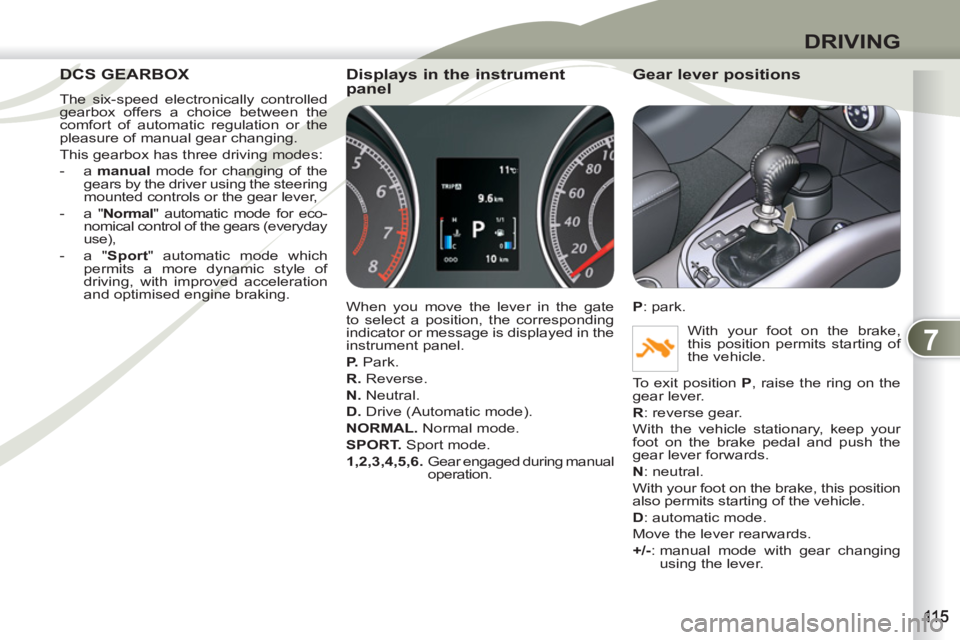
7
DRIVING
DCS GEARBOX DCS GEA
The six-speed electronically controlled
gearbox offers a choice between the
comfort of automatic regulation or the
pleasure of manual gear changing.
This gearbox has three driving modes:
- a manual
mode for changing of the
gears by the driver using the steering
mounted controls or the gear lever,
- a " Normal
" automatic mode for eco-
nomical control of the gears (everyday
use),
- a " Sport
" automatic mode which
permits a more dynamic style of
driving, with improved acceleration
and optimised engine braking.
Displays in the instrument
panel
When you move the lever in the gate
to select a position, the corresponding
indicator or message is displayed in the
instrument panel.
P.
Park.
R.
Reverse.
N.
Neutral.
D.
Drive (Automatic mode).
NORMAL.
Normal mode.
SPORT.
Sport mode.
1,2,3,4,5,6.
Gear engaged during manual
operation.
Gear lever positions
P
: park.
With your foot on the brake,
this position permits starting of
the vehicle.
To exit position P
, raise the ring on the
gear lever.
R
: reverse gear.
With the vehicle stationary, keep your
foot on the brake pedal and push the
gear lever forwards.
N
: neutral.
With your foot on the brake, this position
also permits starting of the vehicle.
D
: automatic mode.
Move the lever rearwards.
+/-
: manual mode with gear changing
using the lever.
Page 118 of 236
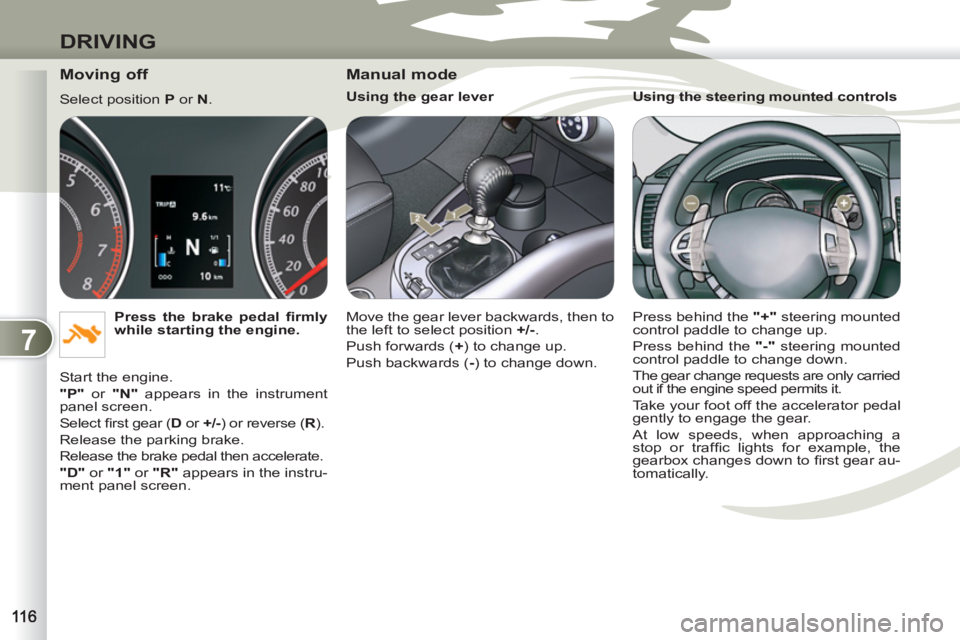
7
DRIVING
Moving off
Select position P
or N
.
Press the brake pedal fi rmly
while starting the engine.
Start the engine.
"P"
or "N"
appears in the instrument
panel screen.
Select fi rst gear ( D
or +/-
) or reverse ( R
).
Release the parking brake.
Release the brake pedal then accelerate.
"D"
or "1"
or "R"
appears in the instru-
ment panel screen.
Manual mode
Using the gear lever
Move the gear lever backwards, then to
the left to select position +/-
.
Push forwards ( +
) to change up.
Push backwards ( -
) to change down.
Using the steering mounted controls
Press behind the "+"
steering mounted
control paddle to change up.
Press behind the "-"
steering mounted
control paddle to change down.
The gear change requests are only carried
out if the engine speed permits it.
Take your foot off the accelerator pedal
gently to engage the gear.
At low speeds, when approaching a
stop or traffi c lights for example, the
gearbox changes down to fi rst gear au-
tomatically.
Page 119 of 236
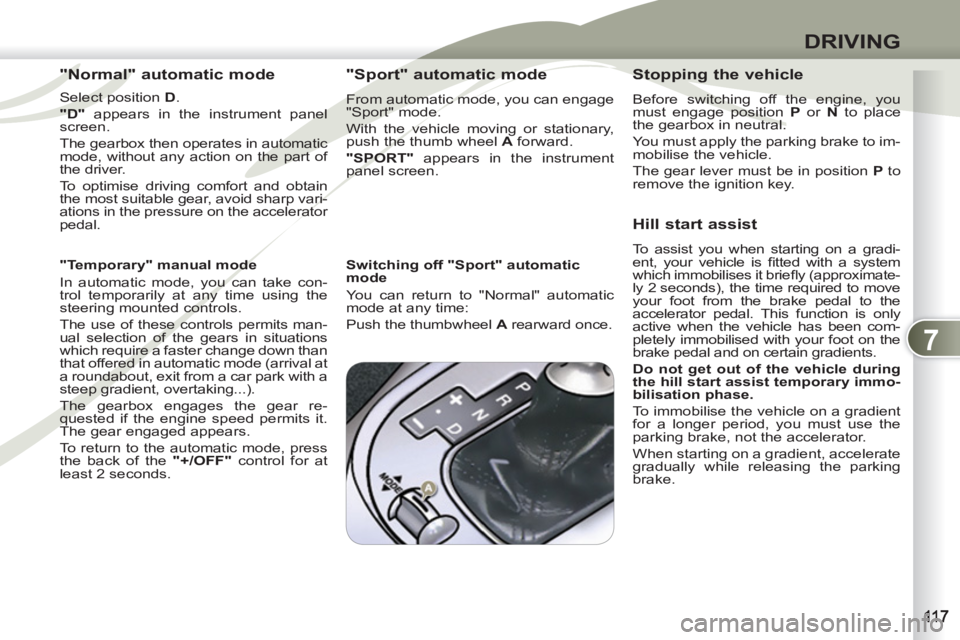
7
DRIVING
"Normal" automatic mode
Select position D
.
"D"
appears in the instrument panel
screen.
The gearbox then operates in automatic
mode, without any action on the part of
the driver.
To optimise driving comfort and obtain
the most suitable gear, avoid sharp vari-
ations in the pressure on the accelerator
pedal.
"Temporary" manual mode
In automatic mode, you can take con-
trol temporarily at any time using the
steering mounted controls.
The use of these controls permits man-
ual selection of the gears in situations
which require a faster change down than
that offered in automatic mode (arrival at
a roundabout, exit from a car park with a
steep gradient, overtaking...).
The gearbox engages the gear re-
quested if the engine speed permits it.
The gear engaged appears.
To return to the automatic mode, press
the back of the "+/OFF"
control for at
least 2 seconds.
"Sport" automatic mode
From automatic mode, you can engage
"Sport" mode.
With the vehicle moving or stationary,
push the thumb wheel A
forward.
"SPORT"
appears in the instrument
panel screen.
Switching off "Sport" automatic
mode
You can return to "Normal" automatic
mode at any time:
Push the thumbwheel A
rearward once.
Stopping the vehicle
Before switching off the engine, you
must engage position P
or N
to place
the gearbox in neutral.
You must apply the parking brake to im-
mobilise the vehicle.
The gear lever must be in position P
to
remove the ignition key.
Hill start assist
To assist you when starting on a gradi-
ent, your vehicle is fi tted with a system
which immobilises it briefl y (approximate-
ly 2 seconds), the time required to move
your foot from the brake pedal to the
accelerator pedal. This function is only
active when the vehicle has been com-
pletely immobilised with your foot on the
brake pedal and on certain gradients.
Do not get out of the vehicle during
the hill start assist temporary immo-
bilisation phase.
To immobilise the vehicle on a gradient
for a longer period, you must use the
parking brake, not the accelerator.
When starting on a gradient, accelerate
gradually while releasing the parking
brake.
Page 120 of 236
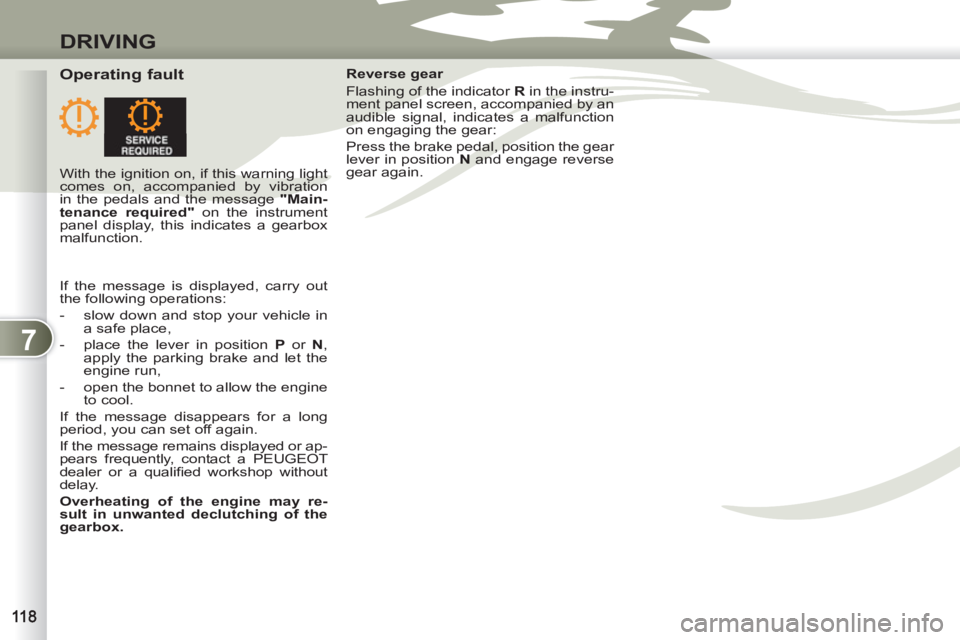
7
DRIVING
Operating fault
Reverse gear
Flashing of the indicator R
in the instru-
ment panel screen, accompanied by an
audible signal, indicates a malfunction
on engaging the gear:
Press the brake pedal, position the gear
lever in position N
and engage reverse
gear again.
With the ignition on, if this warning light
comes on, accompanied by vibration
in the pedals and the message "Main-
tenance required"
on the instrument
panel display, this indicates a gearbox
malfunction.
If the message is displayed, carry out
the following operations:
- slow down and stop your vehicle in
a safe place,
- place the lever in position P
or N
,
apply the parking brake and let the
engine run,
- open the bonnet to allow the engine
to cool.
If the message disappears for a long
period, you can set off again.
If the message remains displayed or ap-
pears frequently, contact a PEUGEOT
dealer or a qualifi ed workshop without
delay.
Overheating of the engine may re-
sult in unwanted declutching of the
gearbox.